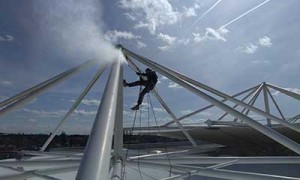
As any educational institution will know, keeping buildings and premises in good condition is important not just for health and safety, but also to provide a pleasant environment that encourages students and staff to thrive. However, both preventative maintenance and urgent repairs can prove challenging, especially when the area in need of work is located at height. Access North Structures is a rope access firm that specialises in such services, and its managing director Berenice Northcott shares one of the team’s recent success stories…
Along with most other modern-day constructions, schools are pushing more structural boundaries than ever before. The inspirational power of design is increasingly being recognised by academic institutions, and schools, colleges and universities alike are building educational facilities that are anything but ordinary. But with structural innovation comes the parallel challenge of technical maintenance, which often requires enlisting the help of experts from outside the gates.
The Bulwell Academy in Nottingham is a perfect example of such an establishment. As well as providing a secure environment for students and staff, the new academy was part of the Building Schools for the Future programme and was designed specifically with modern, 21st century educational needs in mind. Completed in 2010 by construction consultancy Faithful+Gould, the result is a creatively stimulating learning and teaching space for students and teachers alike.
The Structural Brief
Sponsored by Edge Education Foundation, the school now accommodates more than 1,000 students aged between 11 and 19. Learning zones are located throughout the two-storey building, which are easily accessible to all students regardless of any special needs. The architectural design is striking, with the angles and glazing making the academy instantly recognisable. But it is through the main entrance plaza, at the heart of the 11,500m² structure, where the school’s real centre-piece lies
The academy’s internal courtyard is a large communal area, covered by a tensile fabric canopy. Made from PVC – a material renowned for its durability and aesthetic endurance – the inverted-conics structure has a lifespan of around 20 years. Yet despite this longevity, the atypical shape and 10-metre height of the canopy’s peaks makes the regular cleaning and upkeep of them something of a challenge.
Routine Maintenance
For any facility – not just ones with unusual structures or features – routine preventative maintenance can be a huge benefit to the quality and safety of the building, not to mention its appearance. Having a planned schedule in place minimises costly investments, helps to avoid disruption and means that any minor problems can be identified and solved before they evolve into bigger ones, which always end up costing far more.
Recognising the advantages of such a proactive approach, as well as the maintenance challenges posed by the tensile structure, The Bulwell Academy’s new caretaker James Logan decided to bring in the experts for the upkeep of the canopy. Identifying Access North Structures through their expertise in designing, installing, inspecting, cleaning, maintaining and enhancing PVC, PTFE and ETFE structures, a site visit from the height experts was soon arranged.
Inspecting the Site
After an initial audit of the site, it became clear that a full clean of the tensile canopy was required, so this was quoted for by Access North Structures. The team also provided a quotation for a complete structural inspection, from which an in-depth next-step plan could be drawn.
In the meantime, before even placing the order, James enlisted the team to conduct a minor but urgent repair. One of the shackles holding the canopy structure to the building had broken away as a result of Storm Doris, so the maintenance specialists stepped in to quickly fit the vital replacement.
Just days after this interim fix, three ANS engineers returned to site for the inspection. Assessing the canopy for any signs of wear, tear and degradation, the team then devised a maintenance schedule for both the short- and long-term. For instance, while not as urgent as the broken shackle, the installation of a replacement turnbuckle at the end of the roof was deemed a minor job, which would be better tackled sooner rather than later. The engineers recommended other routine maintenance regimes to be conducted at future intervals, to help further optimise the structure’s condition.
Cleaning the Canopy
Organising essential works to fit in with term dates is always a challenge for school caretakers and site managers. So on this occasion, an 8-day deep clean of both the structure’s steelwork and fabric was carried out during the Easter holiday. Using purely rope access techniques, two IRATA-trained technicians scaled the entirety of the canopy, reaching even the most restricted parts without requiring scaffolding or machinery.
For the actual cleaning, the duo used a PVC-specific fluid to break down the excessive build-up of dirt. The resultant effect was not just the revelation of the bright white canopy underneath, but also the restoration of the tensile fabric’s condition. There is no straightforward answer to how often a PVC structure should be cleaned, as the recommended intervals depend largely on the location, function and prior upkeep programme. But, as in this case, regular planned maintenance of the canopy – according to requirements identified through the inspection – should maximise the material’s longevity.
Harnessing the Benefits of Rope Access
As long as it is done by experienced and expertly trained technicians, rope access is widely acknowledged as the safest maintenance method for tensile structures, even those at great heights. Due to the risks involved with any work taking place far above ground, extensive assessments of the site and structure, along with method statements, must be conducted for each separate job. The necessary insurance must also be in place but on the whole, the technique is the safest means of working on both complex constructions and those at a significant height.
Using two connection points, once the team is rigged into position it is easy for them to move around a facility and conduct the required works. Plus, there is absolutely no need for scaffolding or powered access equipment, which helps to lower costs, minimise disruption on-site and considerably reduce the impact on the environment. If necessary, rope access jobs can even be conducted safely at night, making it a 24/7 solution.
Based in West Yorkshire, Access North Structures provides specialist services in rope access, fall protection, ETFE and tensile fabrics across the UK. To find out more about their solutions or to get in touch, visit their website at www.accessnorth.co.uk.
Please submit your comments below.
Do you have something to say about this or any other school management issue which you'd like to share? Then write for us!








